KLHL12
| Kelch-like family member 12 | |||||||||||||
|---|---|---|---|---|---|---|---|---|---|---|---|---|---|
| |||||||||||||
| Identifiers | |||||||||||||
| Symbols | KLHL12 ; C3IP1; DKIR; hDKIR | ||||||||||||
| External IDs | OMIM: 614522 MGI: 2385619 HomoloGene: 23317 GeneCards: KLHL12 Gene | ||||||||||||
| |||||||||||||
| RNA expression pattern | |||||||||||||
 | |||||||||||||
| More reference expression data | |||||||||||||
| Orthologs | |||||||||||||
| Species | Human | Mouse | |||||||||||
| Entrez | 59349 | 240756 | |||||||||||
| Ensembl | ENSG00000117153 | ENSMUSG00000026455 | |||||||||||
| UniProt | Q53G59 | Q8BZM0 | |||||||||||
| RefSeq (mRNA) | NM_021633 | NM_153128 | |||||||||||
| RefSeq (protein) | NP_067646 | NP_694768 | |||||||||||
| Location (UCSC) | Chr 1: 202.86 – 202.9 Mb | Chr 1: 134.46 – 134.49 Mb | |||||||||||
| PubMed search | |||||||||||||
Kelch-like protein 12 is a protein that in humans is encoded by the KLHL12 gene.[1][2]
Interactions
KLHL12 has been shown to interact with RIT1[3] and CUL3.[3]
References
- ↑ Strausberg RL, Feingold EA, Grouse LH, Derge JG, Klausner RD, Collins FS, Wagner L, Shenmen CM, Schuler GD, Altschul SF, Zeeberg B, Buetow KH, Schaefer CF, Bhat NK, Hopkins RF, Jordan H, Moore T, Max SI, Wang J, Hsieh F, Diatchenko L, Marusina K, Farmer AA, Rubin GM, Hong L, Stapleton M, Soares MB, Bonaldo MF, Casavant TL, Scheetz TE, Brownstein MJ, Usdin TB, Toshiyuki S, Carninci P, Prange C, Raha SS, Loquellano NA, Peters GJ, Abramson RD, Mullahy SJ, Bosak SA, McEwan PJ, McKernan KJ, Malek JA, Gunaratne PH, Richards S, Worley KC, Hale S, Garcia AM, Gay LJ, Hulyk SW, Villalon DK, Muzny DM, Sodergren EJ, Lu X, Gibbs RA, Fahey J, Helton E, Ketteman M, Madan A, Rodrigues S, Sanchez A, Whiting M, Madan A, Young AC, Shevchenko Y, Bouffard GG, Blakesley RW, Touchman JW, Green ED, Dickson MC, Rodriguez AC, Grimwood J, Schmutz J, Myers RM, Butterfield YS, Krzywinski MI, Skalska U, Smailus DE, Schnerch A, Schein JE, Jones SJ, Marra MA (Dec 2002). "Generation and initial analysis of more than 15,000 full-length human and mouse cDNA sequences". Proc Natl Acad Sci U S A 99 (26): 16899–903. doi:10.1073/pnas.242603899. PMC 139241. PMID 12477932.
- ↑ "Entrez Gene: KLHL12 kelch-like 12 (Drosophila)".
- ↑ 3.0 3.1 Rondou, Pieter; Haegeman Guy; Vanhoenacker Peter; Van Craenenbroeck Kathleen (Apr 2008). "BTB Protein KLHL12 Targets the Dopamine D4 Receptor for Ubiquitination by a Cul3-based E3 Ligase". J. Biol. Chem. (United States) 283 (17): 11083–96. doi:10.1074/jbc.M708473200. ISSN 0021-9258. PMC 2431063. PMID 18303015.
Further reading
- Maruyama K, Sugano S (1994). "Oligo-capping: a simple method to replace the cap structure of eukaryotic mRNAs with oligoribonucleotides". Gene 138 (1–2): 171–4. doi:10.1016/0378-1119(94)90802-8. PMID 8125298.
- Suzuki Y, Yoshitomo-Nakagawa K, Maruyama K et al. (1997). "Construction and characterization of a full length-enriched and a 5'-end-enriched cDNA library". Gene 200 (1–2): 149–56. doi:10.1016/S0378-1119(97)00411-3. PMID 9373149.
- Ota T, Suzuki Y, Nishikawa T et al. (2004). "Complete sequencing and characterization of 21,243 full-length human cDNAs". Nat. Genet. 36 (1): 40–5. doi:10.1038/ng1285. PMID 14702039.
- Mai A, Jung SK, Yonehara S (2004). "hDKIR, a human homologue of the Drosophila kelch protein, involved in a ring-like structure". Exp. Cell Res. 300 (1): 72–83. doi:10.1016/j.yexcr.2004.06.023. PMID 15383316.
- Gerhard DS, Wagner L, Feingold EA et al. (2004). "The Status, Quality, and Expansion of the NIH Full-Length cDNA Project: The Mammalian Gene Collection (MGC)". Genome Res. 14 (10B): 2121–7. doi:10.1101/gr.2596504. PMC 528928. PMID 15489334.
- Uchida K, Akita Y, Matsuo K et al. (2005). "Identification of specific autoantigens in Sjögren's syndrome by SEREX". Immunology 116 (1): 53–63. doi:10.1111/j.1365-2567.2005.02197.x. PMC 1802401. PMID 16108817.
- Rual JF, Venkatesan K, Hao T et al. (2005). "Towards a proteome-scale map of the human protein-protein interaction network". Nature 437 (7062): 1173–8. doi:10.1038/nature04209. PMID 16189514.
- Angers S, Thorpe CJ, Biechele TL et al. (2006). "The KLHL12-Cullin-3 ubiquitin ligase negatively regulates the Wnt-beta-catenin pathway by targeting Dishevelled for degradation". Nat. Cell Biol. 8 (4): 348–57. doi:10.1038/ncb1381. PMID 16547521.
- Lim J, Hao T, Shaw C et al. (2006). "A protein-protein interaction network for human inherited ataxias and disorders of Purkinje cell degeneration". Cell 125 (4): 801–14. doi:10.1016/j.cell.2006.03.032. PMID 16713569.